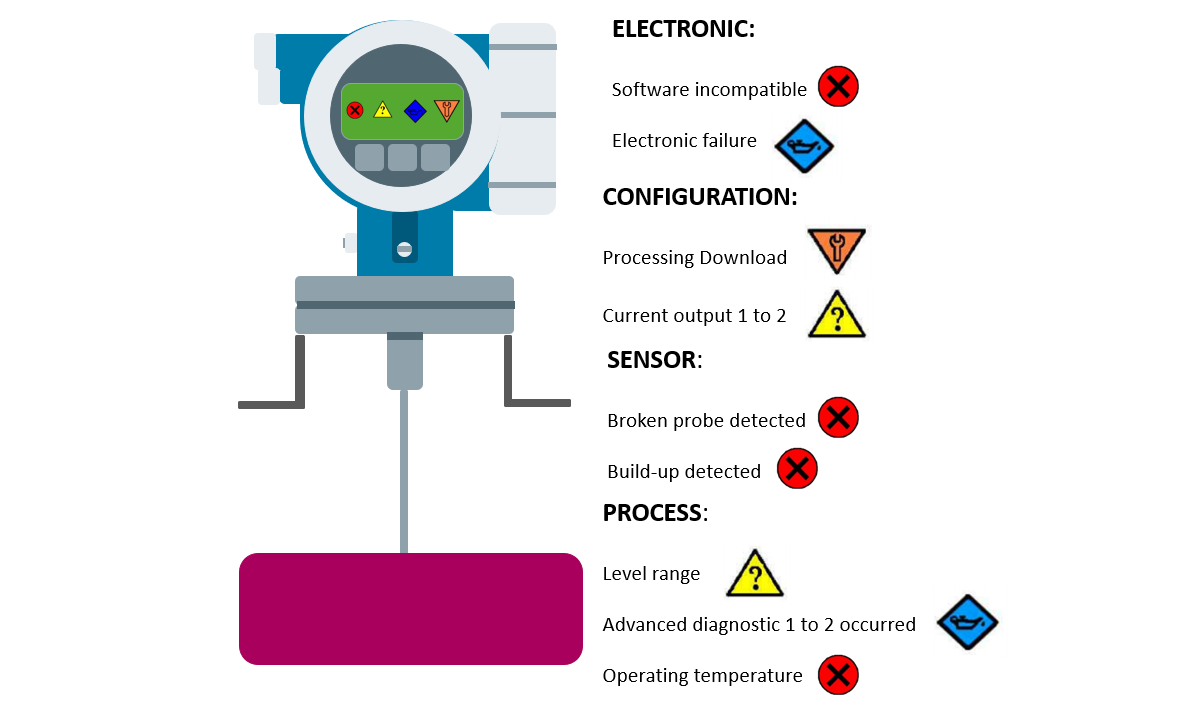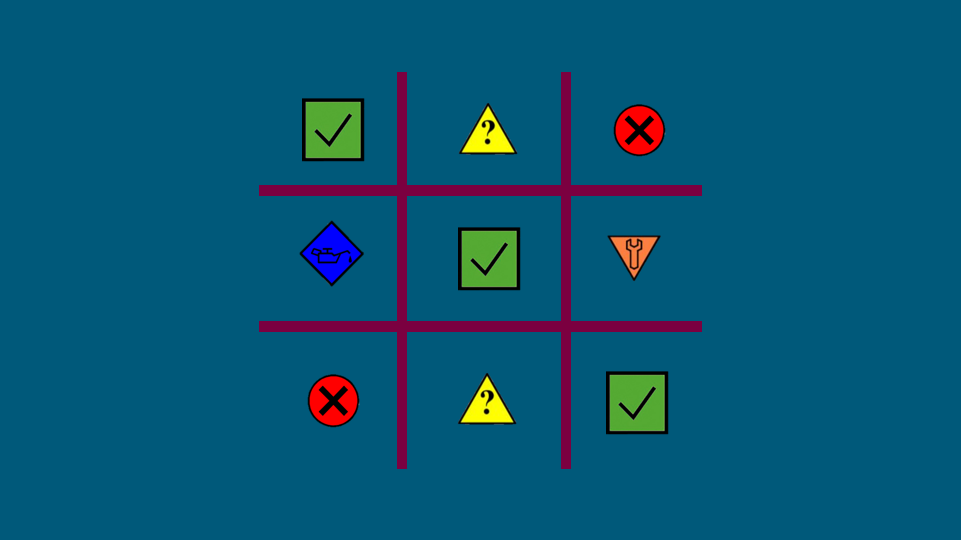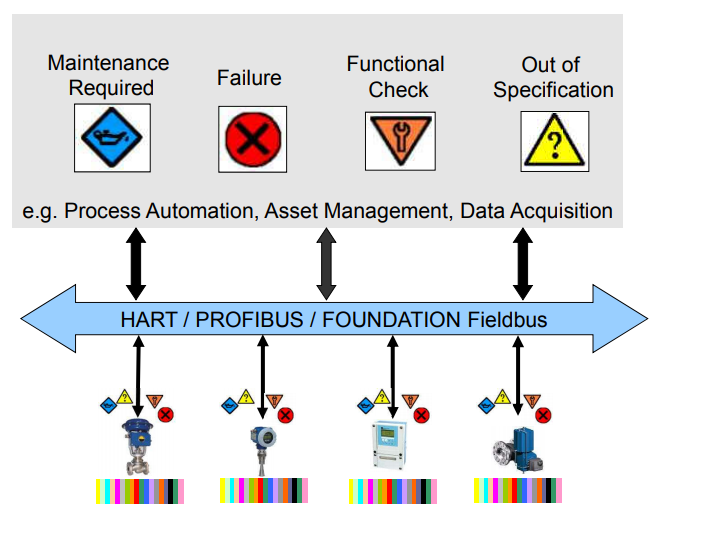Things to know about NAMUR NE 107
NAMUR NE 107 can make life easier, so why don’t we see it in more plants? Learn more about this standard and how to get this information online anywhere.
You need device health information to keep production up, product quality high, and unscheduled shutdowns low to nonexistent. When we talk about health diagnostics, you’ll see NAMUR NE 107 recommendations come up in the conversation.
Can you imagine what a process would be like if all its devices provided their data without standardization? You’d be overwhelmed with technical diagnostics with little idea of what they mean, much less what you need to do! Chaos! No thank you.
Although most industrial plants have some standardization, many endure way more complication than they need. Why? Because they still don’t use NAMUR NE 107 to get simple interpretations from their diagnostics.
Let’s talk about why health status is important and how NAMUR NE 107 recommendations can make monitoring your processes easier. Stick around to find out how to maintain product quality while improving daily tasks!
How does NAMUR NE 107 help with device health status?
Plant operators and technical teams look at the process differently. Plant operators want to keep the process running without unscheduled shutdowns or other factors that could affect the quality and quantity of the product. Fair enough.
Technical teams, either technicians or engineers, also want to keep the process running, of course. But they have to make sure the instrumentation works correctly and provides operators with the process data they need.
While both are working for the same goals, their tasks and the level of information they need differ. The operators need to get basic process information and health status data from their devices without a lot of other distractions. But the techs need a lot more detailed information from the devices so they can take action faster and more accurately to prevent a problem from happening.
The NAMUR NE 107 standard brings together these two realities. It says that operators need to receive the health status from their devices in a uniform way regardless of the type of device.
So NE 107 reduces the chaos into four simple status signals.
And technical teams using intelligent device management (IDM) can access additional information and fix the product faster with this standard than without it. (Some systems show a checkmark in a green box when the device is normal or gray for diagnostics passive, making it even easier to review and proceed.)
What are the four NAMUR NE 107 status signals?
The signals break down into four standard icons and colors, making them easy to understand regardless of the vendor. Let’s go over them - I took the freedom to add a description for a better understanding:
- Check function: Low severity; temporarily invalid signal, such as forced device outputs in loop tests (For status signals prioritization, check function is considered priority 2 by NAMUR)
- Maintenance required: Low severity; valid signal, but function will drop or cease soon, like at the end of a pH sensor's lifetime (For status signals prioritization, the maintenance required is considered priority 3 by NAMUR)
- Out of specification: Medium severity; device is running beyond permissible range or some other parameter (For status signals prioritization, out of specification is considered priority 4 by NAMUR)
- Failure: High severity; invalid signal due to malfunction in a sensor, instrument, or actuator (For status signals prioritization, failure is considered priority 1 by NAMUR)
The severity and priority are a different thing, and they can define as:
"Severity is a parameter to denote the impact of a particular incident on a system. Priority is a parameter to decide the order in which defects should be fixed. Severity means how severe incident is affecting the functionality. Priority means how fast incident has to be fixed." font: Geekforgeeks
This table presents the colors, shapes, and symbols for each signal to show how easy it is to identify each status at a glance:

With the NE 107 standard, a plant operator can receive a simple health-status signal from any self-diagnostic field device, regardless of working principle or vendor, instead of tons of error codes. And the technical team can use software, such as FieldCare from Endress+Hauser and the FDT/DTM technology, to access the details and figure out what’s happening with the device.
Example: NAMUR NE 107 in a radar level transmitter
A health status signal can represent different diagnostics, depending on the field device. With a health monitoring system, such as Netilion Health, you can get organized details and figure it out with a couple of clicks. But without such a system, you’ll see all the information jammed into the device display or control console, making your life more complicated.
Here you can see an example of the four signals for a radar level transmitter, divided into diagnostics of the sensor, electronics, configuration, and process:

This example covers only some diagnostic information; the device can provide a lot more, and you can find the full list of these diagnostics in the vendor's technical manual for the device.
Why isn’t NAMUR NE 107 used in more plants?
Of course, you have access to all these health statuses in any plant when you use a field communicator. With a handheld, you just walk to your device and use the local configuration to figure out the device's health status.
But while self-diagnostic field devices may exist throughout the plant, many of them still operate on the good old analog signal, which makes diagnostic information in the field much harder to come by.
And I've seen many cases where even with digital communication, the technical team and operators don’t know how to check the health status of their instrumentation.
Now, with IIoT services, you can access these types of health status more easily than before, but you need to collect this information to use it. There are many ways to do that, such as using WirelessHART, PROFIBUS, or cloud-connected devices.
We have other articles that discuss these possibilities.
An IIoT health service like Netilion Health can democratize access to data anywhere, anytime. You just need to connect your gateways to the field edge device to delve into the pile of rich data that can improve your plant’s production, your product’s quality and consistency, and your team’s efficiency.
Is the NAMUR NE 107 new?
Nope, it’s not new. Is it older than me? I don't think so, but it has been around for a while. However, IIoT cloud solutions are now making it easier to access, read, and use all of this information in dashboards, archives, and other organized system features.
At this point, you still need control systems and IDM software to dive into the details, but IIoT cloud solutions offer simple access to the data, alerts, and history of your processes.
Want online access to these diagnostics? You can try it out for free.
Hope that convinces you to check out NAMUR NE 107. If you learned something useful from this article, share it with your colleagues on social media using the #Netilion tag.
Have a good one!




